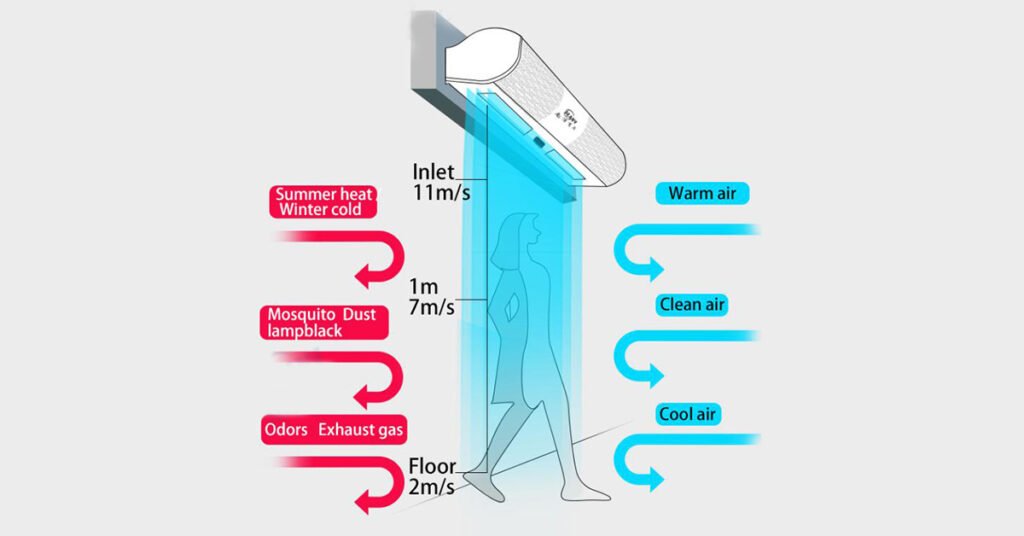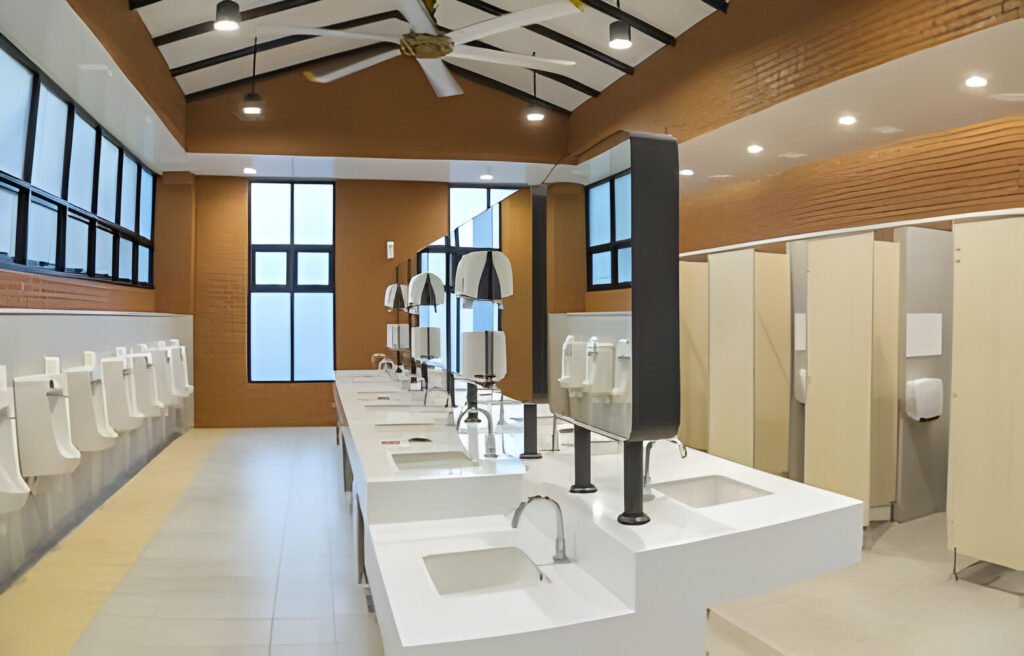Theophilus van Kannel patented the rotating door in 1888, claiming that it would keep
“noxious effluvia” and “baleful miasmas” out of a building when the postman came and went.
The rotating door also made it unnecessary for one person to hold a door open for another
(legend has it that Van Kannel had grown tired of opening doors for his traditionally-minded wife).
The rotating door, however, was not the only invention Van Kannel made to keep cold air and pollutants out of buildings. His second invention was the air curtain, which he patented in 1904 and had its first use in a building in 1916.
What is an air curtain?
An air curtain, sometimes known as an air door, is a barrier that keeps particles or air from escaping from one place to another. A fan positioned above a building’s entryway and facing downward is a traditional air curtain design.
It could also be a gap between two rooms with varying temperatures. It’s a constant stream of air blown from an open doorway’s top to bottom.
Air curtains, commonly used as a second line of defense within a closed-door or to replace hanging plastic flaps in an open entryway, provide a barrier through which people and objects can pass but not air. This means that the climates on opposite sides of the air barriers do not shake hands.
In its most basic form, an air curtain is an air barrier consisting of a continuous broad stream of air that circulates over a conditioned space’s doorway.
What is the use of an air curtain?
An air curtain is a device that uses a fan to create a descending air curtain. Depending on the need for an air curtain has various applications. It can be used in restaurants, hospitals,
drive thrus, shopping malls, warehouses and for personal hygiene as well.
The forced air produces an impenetrable barrier that serves to regulate temperature by preventing hot or cold air from entering a doorway or a structure through an aperture.
Air curtains are also used to prevent insects, dust, pollen, and other waste from entering an interior space. They keep pollutants and other environmental elements out of a location while allowing humans to easily travel between them.
The mechanism of the air curtains?
Internal fans compress the air arriving through the intake grille, which may have filter
functions, and force it through an air outlet, which is directed at the open doorway. The filter
keeps dust and particles out of the inner components (heat exchanger, fans, electronics, and so on).
The air curtain’s fans can be belt-driven or direct-drive. Centrifugal, axial, and
cross-flow are the most common forms. Some air outlets and/or lamellas can be adjusted to improve the air curtain’s effectiveness depending on the situation.
Heated air curtains use a coil to heat or cool the jet (electric, hot/cold water, steam, indirect
or direct gas, direct expansion, etc.). Heating is utilized to prevent people from feeling a frigid blast of air as they cross the entryway, as well as to warm the volume of air entering the Building.
Air is vented from top to bottom of the door by most air curtains, which are positioned
horizontally across the top of the opening. One or both sides of the door might have vertical
air curtains attached.
The most effective in thermodynamic terms is a horizontal installation integrated into the floor, but it is also the most expensive to install and troublesome when public pedestrian traffic crosses the doorway for obvious reasons. As a result, it’s only used in a few niche industrial applications
Types of air curtains
There are two basic varieties of air curtains to choose from, depending on the use and the
goal of the space: non-recirculating (most frequent) and recirculating.
Non – recirculating: Because they are easier and less expensive to install and maintain,
non-recirculating air curtains are more often used than recirculating air curtains. The air
curtain can be positioned horizontally above the door or vertically on one or both sides of the door, depending on the height, width, and physical qualities of the opening. The air curtain is less likely to be damaged if mounted horizontally above the door.
Recirculating: In high-traffic locations like supermarkets and store entrances, recirculating air curtains are typical.They blow air out of a discharge grille on one side of the door, collect it via a receiving grille on the other, and return it to the discharge grille via ductwork.
Recirculating air curtains generate a non-obtrusive wide stream of low-velocity air that is
better for isolating situations.
What is the price of air curtains?
The cost-benefit analysis of an air curtain, like many other economic concerns, is dependent
on several factors. A 36-inch unheated air curtain can cost as low as $200. A high velocity,
heated curtain for a 9-foot by 14-foot door air curtain, on the other hand, can cost about
$450.
The first secret in air curtain economics is to pay for only what one needs. The
magnitude should be self-evident: Measure the door. Next, decide whether one is
comfortable or efficient; generally heated models are more comfortable.
What are the advantages of air curtains?
Commercial Profit:
● Because of the “open door effect,” sales improve. It is well known that when doors
are open, people’s wealth skyrockets.
● Customers feel invited in when the doors are open.
● The doorway serves as a shop window, allowing customers to view the interior of the
store.
● Access is free for disabled individuals (wheelchairs) and people who use baby
strollers, trolleys, umbrellas, and similar items.
● Assist in the control of draughty sensations.
● Increases the amount of useful space available at entrances
● Increases consumer and employee satisfaction
Hygienic environment
● Assists in maintaining a healthy environment.
● Employee absenteeism reduces.
● Insect and pest control
● Airborne dust, pollution, gasses, and foul odors are all blocked by this barrier
Sustaining energy
● Reduces conditioned space energy losses
● Reduces central plant capacity (heating/cooling)
● Reduces building operating costs
● Reduces CO2 emissions
Enhanced safety
● Because there is no physical obstacle, it helps with visibility and avoids collisions.
● Reduces misting, dries up the doorway, and prevents ice from collecting on the floor
in cold areas.
● In the event of a fire or an emergency, easy escape through the exit doorway is
possible.
● Assist as a fire-smoke barrier (special application)
Conclusion
Air curtains are a good approach to divide two different environments. They act as a virtual
barrier in a variety of applications, preventing heat and cooling loss as well as pollutant
passage.







